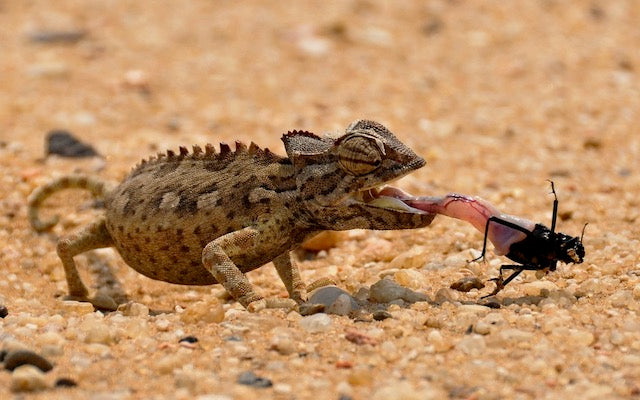When answering the question, “What do chameleons eat?” it’s important to make a distinction between chameleons in the wild and chameleons in captivity. Chameleons are mostly insectivorous opportunistic eaters, snatching up whatever insects are unfortunate enough to cross their path.
In the wild, chameleons sometimes also supplement their insectivorous diet with vegetation. And some of the larger chameleon species are also known to eat the occasional small bird and small reptile.
But before you grab the fruits and vegetables – or even a pinky mouse – to feed to your chameleon, there are a few things you should know about properly managing your chameleon’s diet.
What Do Chameleons Eat in the Wild?
Wild chameleons are opportunistic feeders. Since they tend to be treetop dwellers, most chameleons only have access to flying insects with softer exoskeletons (chitin), caterpillars, and larval worms. It’s rare that they would descend from the treetops to eat ground insects that have a thicker exoskeleton.
To supplement their diet and help clean out their intestinal tract, it’s not uncommon for wild chameleons to occasionally eat some vegetation. Even in captivity, they retain this vegetation-eating instinct. This leads many chameleon keepers to believe that fruits and vegetables are a necessity for their chameleon.
But do pet chameleons need fruits and vegetables as part of their diet?

What Do Pet Chameleons Eat?
The short answer is, no. Chameleons in captivity don’t need fruits and vegetables as part of their diet.
Even in the wild, chameleons are primarily insectivorous. Any vegetation they eat is purely supplemental or opportunistic for when they can’t find bugs. In captivity, there’s no nutritional value to including fruits and vegetables as part of your chameleon’s diet. There’s also a good chance your chameleon will simply reject them.
So what do pet chameleons eat?
The best thing you can offer your pet chameleon is highly-nutritious, gut-loaded insects that are dusted with a high quality calcium/vitamin D3 supplement. Some of the best feeder insects that should be staples in your chameleon’s diet include:
- Crickets
- Dubia roaches
- Grasshoppers
Insects that should be offered only as occasional treats to spice things up include:
- Superworms
- Wax worms
- Butterworms
- Bamboo worms
- Pachnoda grubs
Pro Tip: Only offer insects from your own colonies or that you’ve purchased from a reliable source. Wild insects may carry parasites and/or pesticides that could be harmful to your chameleon.
How Much Do Chameleons Eat?
As opportunistic feeders, chameleons’ feeding habits can be difficult and frustrating to keep track of. You may find that your chameleon will eat a lot one feeding, then eat almost nothing for the next couple of feedings. This is a perfectly normal part of your chameleon’s diet.
Generally speaking, baby and juvenile chameleons need to eat more frequently than adults. For babies, this means feeding twice daily. Many chameleon keepers will let their baby chameleon eat as much as it wants within a five minute window. This usually translates into about 12 to 15 small insects.
Pro Tip: High-protein insects, like Dubia roaches, are vital during the baby and juvenile stages of your chameleon’s development. For adult chameleons, providing a wide variety of insects is key.
Once your chameleon hits about three months of age, you can begin transitioning it to once-a-day feedings. Again, given a five minute window, your juvenile will eat roughly 10 to 15 small insects.
Sub-adult chameleons only need to be fed every other day, and will typically only eat three or four insects per feeding.
Similarly, adults will only eat three or four insects per feeding. However, they only need to be fed every two or three days.
Chameleon Feeding Schedule
|
Stage |
Age |
Frequency |
Amount |
|
Baby |
0-3 Months |
Twice Daily |
As much as it wants |
|
Juvenile |
3-8 Months |
Once Daily |
10-15 bugs |
|
Sub-Adult |
8-9 Months |
Every Other Day |
3-4 bugs |
|
Adult |
12+ Months |
Every 2-3 Days |
3-4 bugs |
Take some time to enjoy the show while you feed your chameleon. Although your chameleon will approach its prey slowly, it launches its long tongue out like a missile. A chameleon’s tongue can go from 0 to 60 mph in 1/100th of a second! It’s a show you won’t want to miss.
Takeaway: In the wild, chameleons are opportunistic feeders that mostly prey on insects. In captivity, your chameleon’s diet should be insectivorous. Feed your chameleon a variety of highly-nutritious, gut-loaded insects like Dubia roaches, crickets, and even grasshoppers.
Your chameleon needs a wide variety of highly-nutritious, gut-loaded insects as the main staple of its diet. The Dubia roaches offered by Dragon’s Diet are a great start to keeping your chameleon well-nourished, happy, and living its best life.








